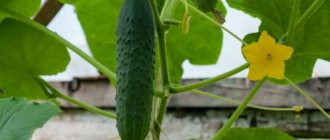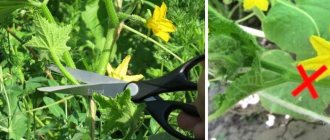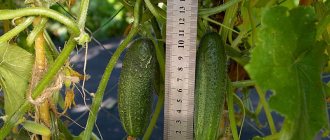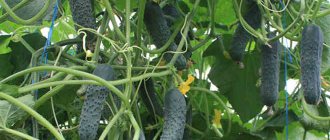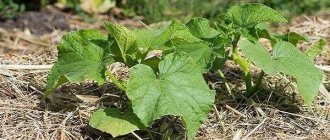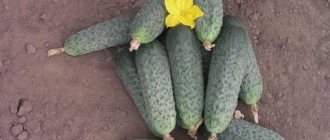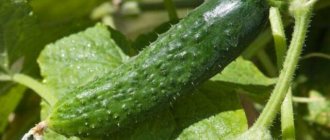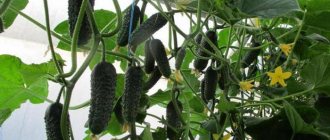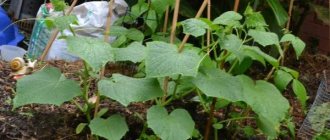- Updated: April 16, 2019
Cucumber varieties Phoenix, Phoenix 640 and Phoenix plus are the most beloved varieties of all gardeners and are therefore cultivated all over the world. They ripen very late, therefore, the first harvest can be obtained only 2 months after germination. It is advisable to grow in open ground with loose soil. Like all other varieties, they do not like drafts too much, which means that the planting site needs to be selected poorly ventilated.
Description of the Phoenix variety
There are 2 types of cucumbers under the name Phoenix. The Phoenix variety of cucumber was created in the 80s of the 20th century by a Russian breeder. Later, an earlier variety of this variety appeared. In the descriptions of the varieties presented below, you can find out what their similar and distinctive features are.
There are 2 types of cucumbers under the name Phoenix
- Phoenix or Phoenix 640, as it is sometimes called, is a sought-after cucumber variety. In 1993, it was included in the State Register of Russia. Recommended for cultivation in the Lower Volga, North Caucasus, and Central regions of Russia. The variety is late (50-62 days), needs pollination. The bush is indeterminate; without growth control it can reach 3 meters or more. The shape of the fruit is cylindrical, simple, with small tubercles and white spines. Length up to 17 cm, weight about 150 g. Purpose: salad.
- Phoenix Plus is a younger variety of the Phoenix variety. Included in the state register of Russia in 2005 and recommended for cultivation in open ground in the North Caucasus region or the Volga region. The variety is mid-season, requires pollination by bees - flowers are of the female type. The bush is indeterminate, with small light green leaves. Zelentsy are medium (50-70 g), spindle-shaped, dark green in color with thin stripes. The tubercles are small. The purpose is salad.
Important!
The Phoenix cucumber is distinguished by its medium-sized fruit and excellent taste. The skin is always without bitterness, and the pulp contains a lot of juice.
Characteristics of Phoenix cucumbers
Also check out these articles
- How to trim onions for long-term storage
- Palm Chamaedorea
- Varieties of climbing roses
- The benefits and harms of cherries for humans
Depending on the variety, the Phoenix cucumber may have certain qualities unique to it.
| Variety of culture | Ripening period | Sustainability | Immunity | Productivity |
| Phoenix or Phoenix 640 | Late | To cold weather, unfavorable growing conditions | Downy and true powdery mildew | 4.5-6 kg/m. sq. Fruiting extended |
| Phoenix plus | Mid-season | To drought, heat | PTO, true and downy mildew | 5-6 kg/m. sq. Extended fruiting |
As you can see, the varieties described are slightly different. It should be taken into account that the features of planting and care are almost the same.
Productivity and ripening time
This variety can be considered very profitable for breeding because it is high-yielding. Cucumber yield rate per 1 sq. meter - 5 kg. In this case, it is necessary to maintain an optimal level of humidity and regularly fertilize the soil.
This variety cannot be called quickly ripening - in order to gain all those properties for which it is so loved by everyone, it needs time. Most often this is about a month and a half (up to 45 days).
Planting Phoenix cucumbers using the seed method
It is recommended to plant Phoenix cucumbers in permeable, aerated soil. Acidity should be between 6.3-7.2. Before planting, the soil should be fertilized with humus and mineral fertilizers. If the soil is clay, then peat and sand are also added. The site is chosen to be bright, sunny, protected from strong winds.
Interesting!
Professional gardeners recommend planting cucumbers in areas where cabbage or potatoes previously grew.
Planting Phoenix cucumbers with seeds
You can grow the Phoenix variety by seeds or seedlings. In the case of seed planting, you need to wait until the ground warms up to +15 degrees (from mid-April to early June) and only then sow cucumbers.
If the seeds are not treated with anything, before sowing they are kept for 15 minutes in a weak solution of potassium permanganate and then dried. The sowing depth of the seeds is 2-3 cm. It is easiest to sow in holes located at a distance of 30-40 cm from each other. You can put 2-3 seeds in one hole, and when they sprout, leave only one, the strongest sprout. After sowing, the seeds are covered with soil and watered. Cucumbers germinate at temperatures of +20...+30 degrees, and after 3-7 days, under favorable conditions, seedlings can be observed.
How to prepare seeds
If the seeds were bought in a store, they must be disinfected. To do this, you need to use a solution of potassium permanganate.
You can collect the seeds yourself from the fruits. An average of 10 seeds can be obtained from one fruit. But before planting they need to be processed. To do this you will need a saline solution. To prepare, such seeds need to be left in it for a day.
Before planting, it is necessary to take into account that seeds collected independently take longer to germinate after planting.
Planting Phoenix cucumbers with seedlings
We recommend reading our other articles
- Savoy cabbage - cultivation and care
- Winter varieties of apple trees
- Planting onions before winter
- The best varieties of cream tomatoes
When growing crops using the seedling method, planting in a greenhouse is carried out in May, and in open ground in June. Seedlings begin to be harvested 25 days before planting. The substrate is prepared from 2 parts of peat, the same amount of humus and 1 part of sawdust. For nutritional value, it is recommended to add a few tablespoons of wood ash. It is best to grow seedlings in paper or peat cups.
Important!
In the shade, cucumbers develop slowly, often get sick, and the greens themselves have a less pleasant taste and may taste bitter.
Planting Phoenix cucumbers with seedlings
Seeds are planted 2-2.5 cm deep and watered. Cover the top of the container with film and keep it at a temperature of +20...+30 degrees until sprouts appear. With 12 hours of lighting, regular watering, daily ventilation (for 15-30 minutes), sprouts will appear on days 3-7.
You need to plant Phoenix cucumber seedlings in a permanent place in holes. By the time of the final transplant, the sprouts should have 3 true developed leaves. Before this, the soil is well fluffed up, watered and then planted. An average of 3-4 plants are planted per square meter. After this procedure, the ground can be mulched, but this is not necessary.
Do you need a greenhouse?
The Phoenix variety is not considered a greenhouse variety. If temperature conditions do not allow growing this variety, then it is better to choose a less demanding one for the greenhouse.
Difficulties you may encounter when growing in a greenhouse:
- In order for the plant to be pollinated, male flowers must be replanted.
- stable temperature required
- it is necessary to control air humidity
- it is necessary to constantly monitor the formation of the course
Caring for cucumber plantings
With proper care, the Phoenix cucumber can please you with a very large, high-quality harvest.
- It is recommended to grow Phoenix cucumbers on a trellis because they can grow very tall, especially in a greenhouse. They begin to be tied after the appearance of 4 leaves.
It is recommended to grow Phoenix cucumbers on a trellis
- Watering is done exclusively with warm, settled water after sunset. You can water the bushes at the root or by sprinkling. Before flowering begins, water is added once a week, after the buds appear - once every 3 days.
- After watering, it is necessary to loosen the soil so that it does not become too compacted. Good aeration is the key to healthy, strong bushes.
- Since the bushes can grow very tall, it is necessary to remove all previous stepsons after the appearance of 3 leaves. Thus, a powerful root system will be formed, and the cucumbers will produce more yield. The same procedure is done after the appearance of the 8th leaf.
- To stimulate the growth of new roots, you can hill up the bushes 1-2 times per season.
- Fertilizers are applied once every 2 weeks from the beginning of flowering. Before the ovaries appear, you can use dung or mullein (a weak solution), and when young cucumbers appear, it is better to use superphosphate in a concentration of 35 g/10 l of water.
Diseases and pests
The variety is resistant to the most popular cucumber diseases:
- powdery mildew;
- downy mildew;
- cucumber mosaic.
But the crop may be affected by white rot or root rot. It is possible to get rid of these diseases only by pulling out the affected areas of the plant and changing the soil to healthy one. If the plant is affected by root rot, then absolutely nothing can be done here. The plant will die. Fungal diseases occur due to drought or excessive soil moisture.
White rot
Very important:
- fix branches to trellises;
- monitor watering;
- loosen the soil in a timely manner;
- regularly examine the culture for disease.
Pests of the Phoenix variety are extremely rare. But if the cucumbers are attacked by spider mites or melon aphids or sprout flies, spray the crop with tobacco or resort to using Karbafos.
As a preventative measure, monitor the plant during the growing season:
- It should not grow very close to each other; do not leave the branches on the ground, tie them to trellises. This way, fungal diseases will have less chance of forming.
- Moderately moist soil and direct aeration also contribute to the prevention of diseases and pests.
- During the growing season, cucumbers can be treated with herbal infusions to prevent the occurrence of aphids and flies.
Proper agricultural technology and care guarantee a healthy plant and an abundant harvest.
Harvesting and processing
Phoenix cucumbers are a salad variety, but they can also be pickled or canned
Depending on the type and location of planting, the Phoenix Plus cucumber can be harvested from mid-May to the end of September. And the Phoenix 640 variety is harvested from August to September. Phoenix is resistant to early cold snaps, and can continue to bear fruit until the end of September or even mid-October. But it is not recommended to keep greens on the bushes for too long, because when they become overripe, their taste deteriorates.
Phoenix cucumbers of any kind are intended primarily for salads, snacks, that is, for fresh consumption. However, given the small size of greens and their pleasant taste, they can also be pickled or canned.
Important!
It is better to harvest Phoenix cucumbers daily, because greens can overgrow and spoil right on the bush. And overripe fruits not only have a less pronounced taste, but also have a hard skin.
Advantages and disadvantages
This varietal variety has many advantages :
- high productivity;
- ease of care;
- immunity to temperature changes;
- drought and cold resistance;
- long fruiting periods;
- long shelf life;
- resistance to various diseases;
- excellent transportability;
- presentable appearance;
- versatility in use;
- excellent taste.
But Phoenix also has its drawbacks . These include:
- limited growing options. Suitable for open ground, but not recommended for growing in greenhouses;
- relatively large fruit sizes.
Advantages of the variety: high yield, long fruiting and storage, versatility of fruits
Reviews from gardeners about the Phoenix cucumber variety
The opinions of gardeners about the Phoenix cucumber variety are presented below.
- Daria Merkushina : “I plant Phoenix 640 cucumber every year. Among many other species that I have tried to grow, for some reason the Phoenix shows the highest yield on my plot. I sow using the seed method, which is easier, but I always cover the plantings with film. The harvest is suitable for salads and winter preparations. I collect fruits until late autumn. After harvesting, the harvest can remain in the refrigerator for a long time without spoiling or losing its taste. So I recommend it for planting - the variety is very good!”
- Maxim Palkin : “We purchased Phoenix cucumber seeds for the first time last year for planting. They sown them in open ground, under film, so that they would germinate faster, but even though the packaging stated that they would germinate in a week, they had to wait about 14 days for germination. But everyone came up! The harvest pleased me with its quantity and taste. The greens are sweetish, very juicy, and crunchy. We ate it fresh, there wasn’t enough for canning!”
- Vlad Zharkov : “I grow cucumbers at the dacha every year, but I often change varieties. I tried the Phoenix Plus variety 2 years ago. Its main advantage is productivity. It produces a lot of beautiful greens, like for sale, and quite tasty. The harvest can be harvested for several months without interruption, but regular feeding and proper care are needed, otherwise the bushes dry out and die. I use the harvest in salads and for pickling.”
History of variety development and place of zoning
This cucumber variety was bred several decades ago, or more precisely, in the early 80s of the last century by breeder A.V. Medvedev in the city of Krymsk. Initially, it was given the name Variety 640. But later, an epidemic of downy mildew occurred across Russia, and as a result, many varieties of this vegetable crop suffered and died. However, Sort 640 was not even affected by this dangerous disease. And as a result, it was given the name Phoenix.
Therefore, you need to remember when choosing seed material that Phoenix and Phoenix 640 are the same variety of cucumbers. There is also the Phoenix Plus variety, a description of which is given at the end of the article.
The variety is zoned for cultivation in the following regions:
- Central Black Earth;
- Middle lane;
- Southern regions and Crimea;
- In the Lower and Middle Volga region;
- In the Caucasus.
